Herbicides
Herbicides are used to control the growth of unwanted plants (weeds). Modern herbicides generally act by restricting growth. They inhibit the action of one or more of the many receptors that catalyze reactions which are essential to the growth of the plant. There is one group however, the auxins, that kill by overstimulating growth. With selective herbicides, either the target in the weed is affected more than that of the crop, the herbicide is degraded more quickly within the crop, or the uptake or translocation of the active ingredient differs from that of weeds. Non-selective herbicides kill crops as well as weeds.
Herbicides can act in several ways:
direct contact with plant tissues, for example, leaves; paraquat is a typical contact herbicide
- by translocation (systemic herbicides),whereby the compound has the ability to be absorbed by aerial plant parts and is transported to roots (basipetal translocation); glyphosate and growth hormones belong to this group
- by root uptake and transportation, to the upper parts of the plant (acropetal translocation)
- through a combination of both methods; triketones are an example of this group as they are transported downwards and upwards
(a) Bipyridyliums
These are non-selective herbicides that act by interfering with photosynthesis. Paraquat is one of the most used:

Although extremely poisonous if swallowed, it binds tightly to soil and is quickly deactivated. It is sold under trade names such as Weedol and Gramoxone.
(b) Auxins
Auxins are plant hormones. The most important member of the family is indole-3-ethanoic acid (indole-3-yl)acetic
acid, IAA).
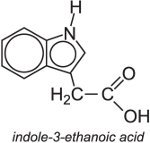
They act by promoting growth of the plant but, given high doses, this can kill the plant and thus act as an herbicide. An example of a synthetic auxin is 2,4-dichlorophenoxyethanoic acid, often known as 2,4-D.
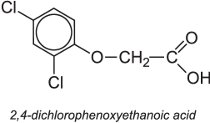
They are often used as one of the salts or esters. They are systemic herbicides and once absorbed act by translocation.
Two commercially sold auxins which mimic IAA are picloram and aminopyralid. They are both selective to broad leaved plants which absorb the herbicide through their leaves and translocate it to the roots. They can be used to kill weeds such as docks, thistles, dandelions and nettles amongst others.
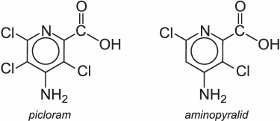
They are degraded by action of microorganisms in the soil and photochemically on the leaf of the plant.

(c) Glycines
Glyphosate ((N-phosphonomethyl)glycine) is a non-selective systemic compound useful in the control of broad-leaved weeds and grasses. It is by far the most widely used herbicide with annual sales well in excess of £3 billion.
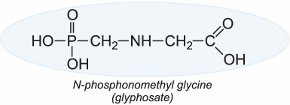
The herbicide is absorbed by the leaves and then translocates to the roots. By inhibiting the action of an enzyme it prevents the production of aromatic amino acids needed by the plants for protein synthesis. As this enzyme is absent in mammals, glyphosate has little toxicity. It is very effective and is rapidly degraded in the soil and by light. It is marketed under many names including Roundup and Tumbleweed.
Although glyphosate is a non-selective herbicide, selective seeds of corn (maize) and soya have been developed (via genetic engineering) whose plants can withstand the herbicide. Thus, fields can be sprayed with the herbicide and these transgenic crops will be the only ones that will not be affected. These seeds are used in many parts of the world but have not been allowed in most EU countries, except in very tightly controlled trials because of public concern about the effect of transgenic crops on the environment.
There have been reports that some weeds have become resistant to glyphosate. However some crops, for example soya, are being developed which are also resistant to auxins such as 2,4-D and so farmers will be able to use a mixture of glyphosate and an auxin.
Glufosinate is another non-selective herbicide.

|
Figure 3 Glufosinate inhibits the formation of glutamine synthetase, an enzyme that forms the amino acid glutamine from glutamate, a process vital for photosynthesis. The weeds around these transgenic soybean plants in the US have been controlled by spraying the whole field with a solution of glufosinate, marketed as Ignite. By kind permission of Bayer CropScience. |
 |
(d) Sulfonylureas
Characteristic features of these chemicals are their potency on a wide range of weeds and their safety to mammals and the environment. They act in plants to block the biosynthesis of essential amino acids (valine and isoleucine), and thus prevent cell division and cell growth.
Mesosulfuron is another example of a herbicide which controls weeds in cereals and is marketed for example as Atlantis.
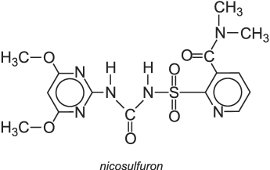
They are selective systemic herbicides which are absorbed by the foliage before translocating through the plant. They are particularly useful in controlling annual grass and dicot weeds in crops such as corn (maize) and are rapidly degraded in soils.
A well known example is nicosulfuron which is marketed, for example, as Accent which is used to control weeds in corn.
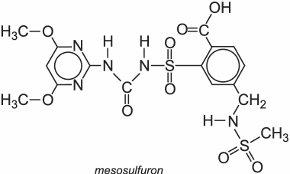

(e) Triketones
The triketones act by inhibiting an enzyme that would have led to the formation of compounds needed in the biosynthesis of carotenoids. These, in turn, play a key role in absorbing light energy for photosynthesis and protecting chlorophyll from photochemical damage. Triketones act through application on the foliage or via the roots. In either case there is translocation through the plant. They are particularly effective in controlling a wide range of weeds. Degradation in soils is fairly rapid.
Tembotrione is an example that allows the control of grasses and broad leaves in corn (Figure 4) and is sold under the trade name Laudis.
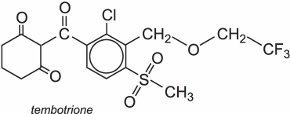
|
Figure 4 The weeds in this field of corn (maize) have been controlled with tembotrione. It has been applied in combination with a compound that triggers degradation of tembotrione in the corn but not in the weeds. Such compounds are known as safeners. By kind permission of Bayer CropScience. |
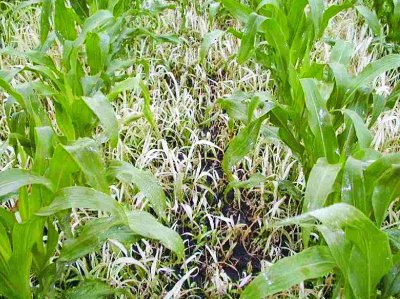 |
Mesotrione is another example of this class of herbicide and is sold under various trade names, including Callisto.
(f) Inhibitors of acetyl-CoA carboxylase
Some herbicides act by inhibiting the action of the enzyme, acetyl-CoA carboxylase, essential for the biosynthesis of carboxylic (fatty) acids, needed by the plant for the production of cell membranes. An example is pinoxaden which is particularly useful in dealing with grass in fields of barley and wheat.
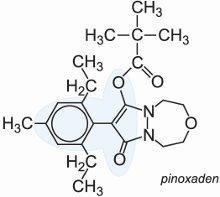
The inhibitors are selective herbicides which are absorbed by the leaves of the plant and act following translocation. They are rapidly degraded in the soil.
Among the trade names for pinoxaden is Axial.
RELATED TAGS: HERBICIDE CHEMICALS PRODUCTION,WHAT IS HERBICIDE,HERBICIDE TO FIGHT,HOW TO FIGHT WITH HERBICIDE,COMPATING HERBICIDE,MAKING HERBICIDE CHEMICALS,CHEMICALS OF HERBICIDE,HOW TO CONPOUND OF HERBICIDE CHEMICALS.HERBICIDE CHEMICALS TO MAKE,FIGHT WLITH HERBICIDE,HERBICIDE CHEMICALS TO USE.
SOLVER CHEM

|
|

|
|

|
|
